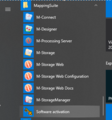ONYX - 9.0 - Installation
ONYX Server installation on Windows
This page explains how to install ONYX Server on Windows.
Sommaire
Requirements
- ONYX Server 9.0 runs under Windows Server 2012 R2, 2016 or 2019
- The Web Apache server version 2.2 or 2.4 must be installed on the server before ONYX Server is installed
- If you wish to call ONYX Server functions via the additional API REST module (web server), install Node.js version 8.10 or more beforehand.
Installing the Mapping server
Launch Setup_ONYX_Server_XXXXX.exe. The setup will execute itself in the following order:
- Home page
- M-Processing Server loading page: this can load for a couple minutes; once it is loaded, a second window opens to install the M-Processing Server
- M-Processing Server Home page
- Terms of use
- Requirements and recommendations: read this page carefully to set the installation environment properly
- Installation folder: choose the M-Processing Server folder, a standard installation path is already filled in by default, however we would recommend you to install it in a folder which is specific to the root of your system drive, ex: C:\Mapping\M-ProcessingServer
- Installation mode: two installation modes are available, Custom or Typical. In both cases, the installation is done in the file chosen previously but the specific configuration options are available in Custom mode. We recommend you to choose the Typical installation mode. You can always come back to the options of the Custom mode and change them after the installation.
- Apache configuration folder: specify the path of the Apache conf folder
- Apache binary folders: specify the path of the Apache bin folder
- Installation parameters: three parameters are required. This data is used to parameter the M-processing Server in the Apache configuration folder: name of the company, name of the server on which the software is installed, IP address of the serveur (we recommend you to use the local loop address "127.0.0.1")
- Installation of the software. Once the software is installed, the end page is displayed, click on the Finish button, ONYX Server is then installed and the following page lets you parameter the basic setup
- Extensions available: list of all the extensions available. Caution: some extensions may need you to abide by some requirements!
- Leave the setup: If no extensions are needed, you leave the setup via the Cancel button in image 12, a popup window will appear, click on Yes to leave the setup.
Installing the API REST extension
Requirements
Node.js version 8.10 or higher must be installed on the server.
Installation
- Link to download Node.js: if Node.js is not installed on the server, this link redirects you to the download page
- Installation parameters: the listening port from which the API REST is available
- Confirm the installation: once you have clicked on the installation button, a loading page appears as the extension is installed
- Loading page: this page shows the state of the installation, this can take a few minutes. Once the extension is installed, an ending page is displayed
Post-installation configuration on Windows
Software keys
Once the installation is finished, the first thing you have to do is enter the license keys.
- Open the Software activation application in the list of applications
- Enter the license keys: check the Software key box, two input fields appear.
- In the first field: enter the product number (number from 1 to 5)
- In the second field: enter the license keys (combination of numbers and uppercase letters, separated by dashes)
Launching the interface
Once the installation is finished, the Apache server needs to be restarted before accessing the managing web interface of ONYX Server.
1. Open your web browser
2. Enter the following URL:
- From the local server:
http://127.0.0.1:8002 - From a workstation in the network:
http://<ip.du.serveur>:8002
8002 being the port configured by default during the installation
Common errors
The 8002 port is already used
In this case, Apache cannot restart. Change the port used to access the web interface of the Mapping server:
- Open the Apache configuration file, httpd.conf (it is located in the conf file, specified during installation)
- Search for the configuration block between #BEGIN_MAPPING and #END_MAPPING (it is usually at the end of the file)
- Change the listening 8002 port in the following lines:
- Listen 8002
- NameVirtualHost *:8002
- <VirtualHost *:8002>
Then, restart the Apache server.
An error message is displayed when opening the page
Errors can occur when opening the Mapping page. If the 2.4 version of Apache was installed, activate the mod_access_compat module in the Apache configuration file, httpd.conf.
To do so:
- Open the Apache configuration file, httpd.conf (it is located in the conf folder, specified during installation)
- Search for the line which contains
mod_acces_compat.so
Delete the # character at the start of the line as can be seen in the following example:
#LoadModule access_compat_module /usr/lib/apache/mod_access_compat.so
LoadModule access_compat_module /usr/lib/apache/mod_access_compat.so
Then, restart the Apache server.
Start the Mapping Spooler
To activate the Mapping spooler:
- Open the M-processing Server interface
- Click on the following icons in this order:
- Management Menu
- Print Management
- Spooler Management
- Start Spooler
Once the spooler is started, a service called Mapping_spooler appears in the list of Windows services (services.msc)
Updating M-Processing Server
- Launch the setup and choose option Repair
- If the question "Do you confirm the update of this environment?" appears, select Yes
- As the server is updating, if an error related to map_daemon.exe occurs, check that the Mapping_Spooler service is stopped. Stop it if it is still active.
- Click on Finish to end the M-Processing Server update and display the extensions window.
Updating the API REST extension
If the extension is already installed, the only option you have is to update it.
- Click on Next to update the extensions.




















